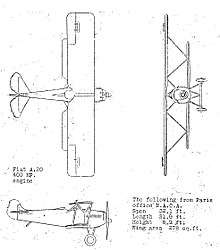Fiat CR.20
| CR.20 | |
|---|---|
 | |
| Role | Fighter |
| Manufacturer | Fiat |
| Designer | Celestino Rosatelli |
| First flight | June 19, 1926 |
| Primary users | Regia Aeronautica Hungarian Air Force |
| Number built | c. 250 CR.20 c. 46 CR.20 Idro c. 235 CR.20bis c. 204 CR.20 Asso |
The Fiat CR.20 was an Italian biplane fighter used during the 1920s and 1930s. Designed by Celestino Rosatelli, it represented an intermediate step from the early biplane CR.1 and the later, successful series CR.30-CR.32-CR.42.
For the new aircraft, Rosatelli used a traditional sesquiplane configuration. The engine was a water-cooled 306 kW (410 hp) Fiat A.20 V-12 engine.
Major variants were the CR.20 Idro, a pontoon floatplane, and the CR.20 Asso, using a more powerful (336 kW/450 hp) Isotta Fraschini engine. CR.20bis, produced from 1930, differed from the original version only with the addition of a more advanced landing gear.
At its peak in 1933, the CR.20 equipped 27 squadrons of the Italian Regia Aeronautica. The aircraft was used against Libyan rebels and in the early stages of the Second Italo-Abyssinian War in the attack role.[1] The CR.20s remained in service with the Regia Aeronautica in the aerobatics and training until the 1930s. In 1933, Italy sold five CR.20s to Paraguay, which was fighting the Chaco War against Bolivia, these serving as Paraguay's only fighters through to the end of the war.[2]
Variants
- CR.20 Idro : Twin-float seaplane version.
- CR.20bis : Single-seat fighter biplane, fitted with an advanced landing gear.
- CR.20bisAQ : CR.20bis aircraft fitted with the Fiat A.20 A.Q. piston-engine.
- CR.20 Asso : Single-seat fighter biplane, powered by a 336 kW (450 hp) Isotta Fraschini Asso Caccia engine.
- CR.20B : Two-seat trainer, communications aircraft. Built in small numbers.
Operators
- Soviet Air Force - Two aircraft, used for tests and trials.
Specifications (CR.20)

Data from The Complete Book of Fighters [3]
General characteristics
- Crew: one, pilot
- Length: 6.70 m (21 ft 11¾ in)
- Wingspan: 9.80 m (32 ft 1¾ in)
- Height: 2.75 m (9 ft 0 in)
- Wing area: 25.65 m² (276.1 ft²)
- Empty weight: 980 kg (2,160 lb)
- Loaded weight: 1,400 kg (3,068 lb)
- Powerplant: 1 × Fiat A.20, 331 kW (420 hp)
Performance
- Maximum speed: 270 km/h (146 knots, 168 mph)
- Range: 750 km[4] (460 m)
- Endurance: 3 hours
- Service ceiling: 7,500 m[5] (24,600 ft)
- Climb to 5,000 m (16,400 ft): 13.62 min
Armament
- Guns: 2 × 7.7 mm (.303 in) machine guns
See also
Related lists
References
| Wikimedia Commons has media related to Fiat CR.20. |
- Notes
- Bibliography
- Angelucci, Enzo. The Rand McNally Encyclopedia of Military Aircraft, 1914-1980. San Diego, California: The Military Press, 1983. ISBN 0-517-41021-4.
- Green, William and Gordon Swanborough. The Complete Book of Fighters. New York:Smithmark, 1994. ISBN 0-8317-3939-8.
- von Rauch, Gerd. "The Green Hell Air War". Air Enthusiast Quarterly, Number Two, 1976, pp. 207–213. Bromley, UK:Pilot Press.
- Taylor, Michael J.H. Warplanes of the World 1918-1939. London: Ian Allen, 1981. ISBN 0-7110-1078-1.